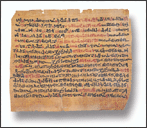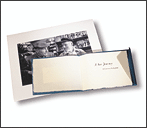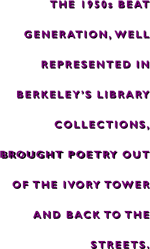

Its white marble steps are worn thin by the passage of countless feet, and its tall columns headquarter a library collection so vast that, if you had a mind to, you could borrow a new book every day for the next 200 centuries.
Mark Twain's legacy of letters and manuscripts are in Berkeley's University Library. So are the nation's second largest collection of ancient Egyptian papyri, the world's biggest Hermann Hesse archive, and the writings of Jack Kerouac, Lawrence Ferlinghetti and other Beat Generation poets. There's even the first-ever sketch of San Francisco.
 But far more numerous than the famous items are those that are obscure. Some, for example, detail the least studied people on earth -- or point to their hidden histories.
But far more numerous than the famous items are those that are obscure. Some, for example, detail the least studied people on earth -- or point to their hidden histories.
Consider the story of the Codex Fernandez Leal and how it was found.
This priceless, ancient relic is a brilliantly painted history from the New World. About 1,000 years old, the codex is a story, told in pictures on tan fiber, about 700 years in the life of an ancient Native American tribe that lived just south of the Aztec nation in what today is Mexico.
Long ago, the conquering Spaniards burned most such pre-Columbian histories. But in the 1940s, UC Berkeley research fellow John Barr Tompkins was on the trail of the codex. Records indicated it had survived -- somewhere.
He searched the libraries of the western hemisphere. But it was only when he returned to Berkeley and climbed the marble steps of Doe Library to the very top floor that he happened upon the key. There, an old catalog hinted he should look to W. H. Crocker, one-time scion of the San Francisco banking family. When Tompkins contacted Crocker's descendants, who were unaware of the priceless codex, they searched and found it tucked away in a musty bank vault.
Today, it resides at the Bancroft Library and, though too fragile to be displayed, slides of its many images are available.
This tale of how an unpretentious library record led to a great discovery explains why the library's massive collections are so valuable: Berkeley believes that wherever scholars may wander, they should never meet a dead end.
This philosophy is why the University Library has been recognized worldwide and why concerns about its future go to the heart of the entire institution.
With that in mind, UC Berkeley's new Chancellor Robert M. Berdahl announced in his inaugural address this spring that shoring up Berkeley's collections is a top concern for the campus. He is allocating $5.5 million in new library funding over the next three years and expects, in time, to match once again what other top universities are spending.
In addition, Berkeley's Campaign for the New Century has set a goal of raising $25 million for library collections. So far, nearly $15 million has been raised toward building the library's endowment, one of the lowest among the nation's top libraries.
The money comes at a welcome moment. The library is rated highly -- number four in the U.S. for the size of its collection. But, like most every research library, it has been struggling for years to fend off flat or falling buying power.
"There was jubilation, there was real jubilation," said Barbara Kornstein, associate university librarian for the social sciences, of Berdahl's pledge to help the library and his $5.5 million allocation.
It was not that previous chancellors and other senior administrators had not equally appreciated the great value of the library. In fact, they had attempted to protect the collections budget during the campuswide budget cutbacks of the early 1990s. But now that the financial climate has improved, and with Berdahl's arrival, there is a feeling that the library has a champion.
"We felt like the boy who cried, 'Wolf!,' but there really was a wolf," said Associate University Librarian Jim Spohrer, who manages the humanities collection. "One of the great things about Bob Berdahl is he knows a wolf when he sees one."
What shape that wolf takes depends on who you ask. But all concerned blame the library's woes on at least two things. First, the deep recession California experienced in the late 1980s and early 1990s hit the Berkeley library especially hard. Second, at the same time, prices for books and periodicals rose far more than the cost of inflation.
"When I came to Berkeley in 1983, we were adding 300,000 volumes to the collection each fiscal year.... In 1994, the number of books acquired dipped to nearly 150,000," said Spohrer.
In desperation, the library was forced to cut a third of its staff to cover budget shortfalls. Still, there were not enough dollars to purchase and preserve the collection as the library had done in the past, and buying power plummeted.
"There was a well perceived decline in the program by the library staff," Spohrer said.
And not only by the library staff.
Distinguished UC Berkeley historian Leon Litwack stepped forward and decried the loss of the library's soul. Students and faculty called on the state to save its irreplaceable collection for future generations. And bewildered alumni wondered what could be happening at Berkeley.
Even last year, as the state posted record revenues, the library continued taking cuts.
Into this situation stepped the new chancellor. Within a week of assuming the helm, Berdahl was bombarded from all sides about the library situation.
So he and Executive Vice Chancellor and Provost Carol T. Christ commissioned a faculty "blue ribbon" report on the library and appointed a committee chaired by then Dean of Humanities Anthony Newcomb. Also crusading for the library was the Academic Senate Library Committee, led by Rhetoric Professor Marianne Constable.
Both groups came to similar conclusions about inflation and declining funds. There were many suggestions about what was needed, but at the heart of the matter was more money, which now has been allocated.
Exactly where the infusion of dollars will go is not clear. Former University Librarian Peter Lyman -- who "deserves a lot of credit for hard work and a commitment to the library," said Berdahl -- stepped down July 1, and the library is looking for a new leader.
No matter who comes aboard to direct priorities, however, much of the new money will go to shore up Berkeley's magnificent collections, the chancellor said.
"If you don't fix a sidewalk for a few years, it might be inconvenient or unsightly but you can restore it to be a perfectly good sidewalk," he said. "But if you let a library go for two or three or four years, you cannot restore it in terms of the collections. Materials are no longer available. You can never recover from that kind of deferred maintenance."
"Berkeley's greatness is its greatest burden," sighed Millicent "Penny" Abell, the campus's interim university librarian and former head of the Yale and UC San Diego library systems.
"What makes Berkeley different and such an incredible resource is the size of its collections. But the explosion of publications and the high rate of inflation in materials puts extraordinary pressure on the library staff and budget. Then you compound that with the digital revolution and, I would add, though not many people talk about it, the extraordinary problem of the preservation of all these materials," she said.
Electronic materials contribute less to the library budget shortfall than many people think, said Berdahl, since they absorb not more than five percent of the total collections budget. But he knows both digital and print are important.
"In my work, I was reading stuff that hadn't been checked out this century," said Berdahl, an historian. "I will see to it that the introduction of new technology is not made at the expense of maintaining our collections."
To the chancellor, inflation is the underlying library problem. Particularly, he points to mathematics and science journals, essential to the advancement of knowledge but available only at a high subscription price. The skyrocketing costs of these journals routinely provoke charges of usury from the faculty.
"They don't pay us, then they soak the library," charged Math Professor Robion Kirby. "We do research and write a paper. We submit the paper to a journal editor, who is usually not paid by the journal. The editor sends it to be reviewed by another mathematician, who is not paid by the journal. Then the journal turns around and sells our content and our work back to our library at a high cost."
Kirby determined that among similar prestigious math journals, those run by commercial publishers charge seven or eight times as much as those from university presses or other nonprofit publishers.
Based on his findings, "I put out a call to other mathematicians to sort of boycott the high-priced journals," Kirby said. "As far as I can tell, these huge publishing empires can cut their prices by two-thirds and still make a profit."
But the success of such a boycott is iffy.
To get published in prestigious journals, "there are those of us who would sell our souls," James Perley, president of the American Association of University Professors, told the New York Times last year.
Kirby took his grievances to one publisher, throwing about statistics as a math professor will. The slick replies ignored his numbers.
"I regret that you describe us in your letter as part of the problem, not the solution," the publisher said. "(We are) ... driven by our ambition to ensure an efficient and enhanced infrastructure for the dissemination of scientific information."
Not likely, said Kirby.
"They've observed they can raise prices about 13 percent a year and still sell their product," he said. "They are simply charging what the market will bear.
"So many academics are clueless over this issue, and they just keep telling their libraries they need these journals. The libraries have been trying to tell us about the cost problem, but we haven't been listening."
The cruelty is that, in a zero-sum game, if one cost goes up, something else has to go down. And that something else has been purchasing power and library staffing. This is a tough tradeoff, even for scientists who rely on journals.
"Part of what's so great about the Berkeley library is you can look up the latest endocrinological research in biochemistry and at the same time get the proceedings of the Linnean Society of London from the 1850s," said Psychology Professor Stephen Glickman. "The library holdings really facilitate one's teaching and research here at Berkeley."
Glickman is a behavioral biologist who studies the central nervous system. He made his name showing how the female hyena dominates the male, and his hormone research appears regularly in Science and other top-notch journals. But when he needed to know about human attitudes toward hyenas, he turned to the library, where he found the voice of Sir Walter Raleigh.
"This is something you just couldn't get at most libraries -- an early edition of Raleigh," Glickman marveled.
Library finds of this kind abound. Recently, a lost opera by Alessandro Scarlatti turned up in Berkeley's music library. John Roberts, head of the library, found the only complete score of Scarlatti's long lost "L'Aldimiro" on the shelves of his own collection in 1989.
"As soon as I saw it, I knew it was important," said Roberts. "It was clearly a contemporary copy of a late 17th century opera, and there simply aren't that many of them in the world."
Though everyone enjoys such tales, even the person responsible for rare books at Berkeley warns against being fooled. Great finds are only a tiny piece of the library picture.
"I always bridle at the use of the word 'treasure' when talking about libraries," said Anthony Bliss, the Bancroft's curator of rare books and literary manuscripts. "That's not the point. The UC Berkeley libraries are hard-working institutions that exist to support teaching and research. They also preserve our written, audio and visual heritage. In the process of doing so, the libraries have become an international resource."
On any given day, the library does indeed draw crowds. Through its doors and through cyberspace stream hordes of people who come solely to tap collections. For instance, during the devastating 1991 Oakland hills fire, "we were the first line of contact for an amazing array of people from the community who were desperate to find blueprints and floor plans to rebuild their homes," said Deborah Sommer, environmental design librarian. "It was so horrible, the weeks after the fire we saw a steady stream of people who were devastated. Seeing the plans here, at least there was that much left from the ashes. I think it was a way for them to find some continuity with what they had lost."
Such visitors come, go, are received warmly by the library and as cordially take their leave. But despite the library's challenges, its soul will remain the generations of Cal students who never quite depart. One such alumna was author Joan Didion, a 1956 graduate who, in an essay 40 years later, wrote fondly of Berkeley:
"I loved walking up from the campus in the late afternoon and watching the fog blow in. I loved walking down past LSB and seeing the bay come into view. I loved passing those places on the campus where the creek could be heard but not seen.... I loved sitting on the balcony in the Morrison Library and listening to recordings of poets reading their own poetry and imagining that I lived in the burnished light of all this splendor."
by Kathleen Scalise
![]()




[Table of Contents] [Berkeley Magazine Home] [UC Berkeley Home Page]
Copyright 1998, Regents of the University of California. All rights reserved.
Comments? E-mail ucbwww@pa.urel.berkeley.edu.